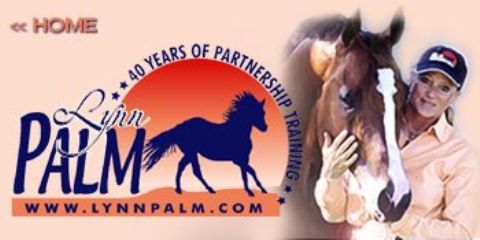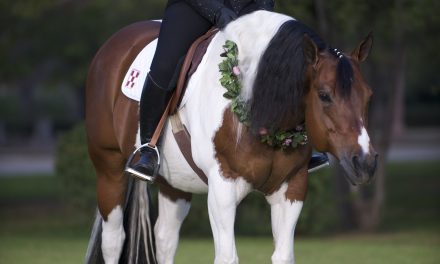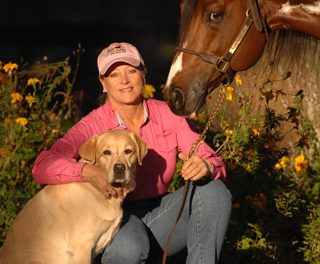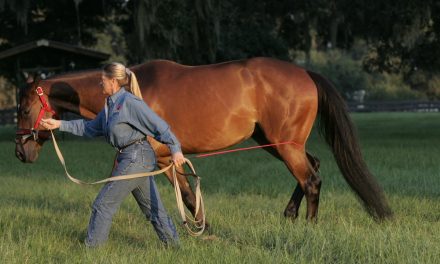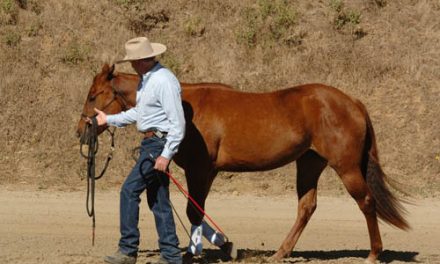Building A Partnership With Your Horse
 In the last article, I discussed readying the horse for work outside the box by releasing his inner energy through forced exercise so that he can concentrate on the task at hand. In this article, I will discuss how to prepare you, the rider, for your riding sessions by loosening up your joints and muscles through stretching exercises.
In the last article, I discussed readying the horse for work outside the box by releasing his inner energy through forced exercise so that he can concentrate on the task at hand. In this article, I will discuss how to prepare you, the rider, for your riding sessions by loosening up your joints and muscles through stretching exercises.
Stretching should start with the rider standing on the ground next to his/her horse. The horse should be tacked up and ready to ride. Doing these stretches next to your horse not only limbers up your body, but it also teaches your horse to stand patiently while you are doing them. Standing and waiting for his rider to complete the exercises, keeps the horse thinking “slow.” When the on-the-ground exercises are completed, the rider can mount her tacked horse and continue on with under saddle stretches.
As with all physical activities, if you experience any pain or have medical conditions that could be complicated by doing any of these exercises, STOP! Seek advice from a health care professional before resuming physical activity.
Some of these exercises will be familiar to you as they were covered in the series on respecting the rider’s form. All of the stretches should be done very slowly. Do several repetitions before moving on to the next exercise. Be sure to breathe when doing them. This is important because it encourages relaxation. If you find yourself holding your breath, try talking or singing to encourage regular breathing.
Head-to-Toe On-the-Ground Exercises
Head and Neck Stretch:
The purpose of this exercise is to stretch neck and shoulder muscles. Stand evenly on both feet with your arms straight down at your sides. Looking straight ahead, inhale and very slowly lift your chin up as far as possible. Hold this position for a few seconds, exhale, and then very slowly lower your chin to your chest. Hold for a few seconds, and then return to the straight ahead position. Keep your shoulders down and relaxed. Continue these stretches until your neck and shoulders feel relaxed.
Head Rotations:
Like the previous stretch, this exercise helps relax the shoulder and neck muscles. The key to making this exercise effective is to only move the head. Lower the chin to the chest and slowly rotate the head, with the chin down, toward the left shoulder, and then the right. I like to close my eyes when doing this exercise because it helps me relax and move slowly.
Shoulder Shrugs:
Inhale and bring both shoulders straight up as if trying to touch the earlobes. Hold for a few seconds, and then exhale and relax the shoulders down. Do several repetitions
Arm Rotations or “One Arm Backstrokes”:
This one is good for loosening up the shoulder and upper back muscles. Extend the right arm in front of you with palm down and fingers pointed. Keeping your eyes on the hand, rotate the arm in a full 360-degree arc: up overhead, behind you, down alongside your leg, and back to the starting position. Always keep the palm facing towards the ground. The challenge is to maintain proper lower body position and not twist your body as the arm is rotated. Do several repetitions, and then do with the left arm.
Back Stretches:
Extend both arms in front of you and parallel to the ground. Keep your chin level throughout the exercise. Breathe in as you bring both arms up slowly. Lift the arms until they are next to your ears and fully extended upward. Hold this stretch. Bring the arms down slowly as you exhale slowly. After the arms are down, end by pushing the shoulders down.
Slow Leg Swings:
This exercise works the pelvic area and the muscles in front of the thigh called the quadriceps. Stand on the horse’s left side with your right hand holding on to the side of the saddle to keep your body centered. Slowly swing the entire leg forward as far as possible, and then extend it backwards. Keep the knee slightly bent. To be effective, the movement must come from the hip joint and not from swinging the lower leg from the knee. Keep the upper body as centered and still as possible. Do several swings with one leg, and then turn so you are facing to the rear and hold the saddle with the left hand and do the exercise with the other leg.
The horse should stand still for this exercise. If he does not, position him next to a fence or other stationary object. This will help him stay straight and stand still. If he continues to move, he may be telling you that he has inner energy that needs to be released through a forced exercise like longeing.
Side Leg Lifts:
This exercise limbers up the inner thigh muscles and flexes the hips. Stand on the horse’s left side and hold on to the saddle with the right hand for stability. Stand on your right leg and slowly lift the left leg out to the side. Keep the knee straight. Slowly lower the leg. Maintain a straight posture and avoid leaning while lifting the leg. Do several repetitions, turn, and do with the other leg.
Runner’s Stretch:
Here is the equestrian version of a classic stretch that limbers up the calf muscles. Stand facing the horse’s left side with both feet together. Put both hands on the saddle or the withers for support. Step back with the right leg and extend it behind you. Keep the right knee very slightly bent and the right foot flat on the ground. Bend the left knee and lean forward slightly. You should feel a nice stretch in the back of the calf. For more stretch, bring the hips forward. Hold this stretch, but do not bounce or force it! If the horse moves away from you, you are pushing on the saddle too much and not stretching enough.
Ankle Rotations:
This exercise increases ankle flexibility while improving balance. Stand on the horse’s left side, facing forward. Bring the left leg up, with bent knee, and hold it with the left hand beneath the knee. Rotate the left ankle in a circular motion inwards toward the horse. Next, rotate the ankle outwards. Do several sets of rotations before turning and repeating with the opposite ankle.
In the next article, I will continue to prepare the rider for training sessions outside the box with some under saddle exercises. In the meantime, if you would like to work ahead on your own, my book Head to Toe Horsemanship and my video series Exercises for Equestrians are excellent resources. My E-Book, Training Outside the Box, will give you all the details for how to optimize your enjoyment of training outside the box. Purchase these and other fine training products at www.lynnpalm.com or by contacting us at 1-800-503-2824

